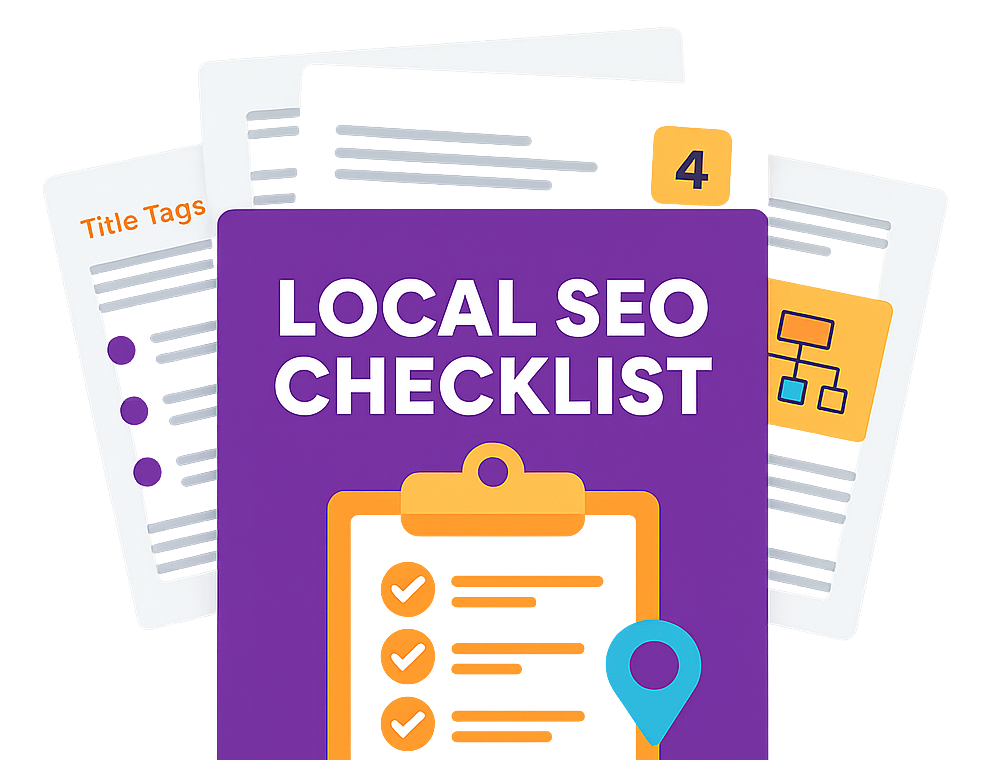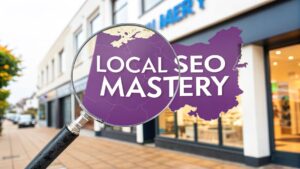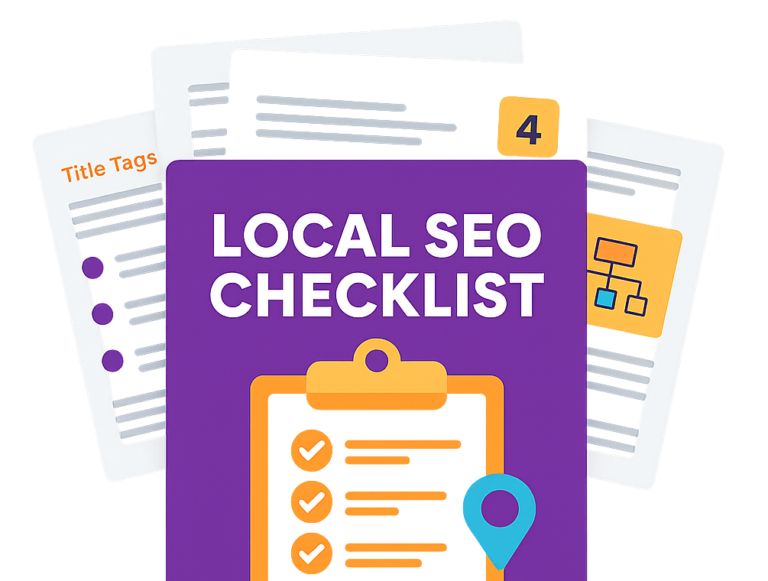Launching a new website is an exhilarating moment, but ensuring it gets discovered by the right audience is the real challenge. Without a solid foundation in search engine optimisation (SEO), even the most beautifully designed site can remain invisible. This is where a structured approach becomes critical. A comprehensive SEO checklist for a new website acts as your roadmap, guiding you through the essential steps to ensure search engines like Google can find, understand, and rank your content effectively from day one.
This guide provides a detailed, step-by-step plan covering everything from the technical nuts and bolts to strategic content creation and authority building. We will walk through the core pillars of a successful launch, including:
- Technical SEO foundation and auditing.
- In-depth keyword research and content strategy.
- Page-level optimisation for maximum impact.
- Content creation frameworks and promotion.
- Foundational link-building tactics.
- Performance monitoring and analytics setup.
By following this plan, you can avoid common pitfalls that hinder new sites and build a powerful online presence that attracts organic traffic, generates leads, and drives sustainable growth. For businesses in Cambridgeshire seeking expert guidance, a specialist agency can provide a tailored SEO Health Check to kickstart this process, ensuring no stone is left unturned. If you find your site is completely absent from search results after your initial setup, troubleshooting if your website isn't showing up on Google is a critical next step to diagnose and fix indexing problems before you proceed.
1. Technical SEO Foundation Audit
Before you write a single word of content or reach out for your first backlink, you must ensure your website’s technical foundation is solid. A Technical SEO Foundation Audit is a non-negotiable first step in our seo checklist for new website. It's a comprehensive assessment of your site's infrastructure, performance, and accessibility, ensuring that search engines like Google can efficiently crawl, interpret, and index your pages without encountering critical errors.
Think of your website as a new house. A technical audit is the equivalent of checking the foundations, plumbing, and electrical wiring. If these core elements are faulty, it doesn't matter how beautifully you decorate the rooms (your content); the house will have fundamental problems. Neglecting this step means any future investment in content creation or link building could be severely undermined by hidden technical roadblocks.
Key Actions for Your Technical Audit
To get started, focus on these critical areas. This initial audit sets the stage for a healthy, high-performing website from day one.
-
Set Up Essential Tools: Your first action should be to create and verify your accounts for Google Search Console and Bing Webmaster Tools. These free platforms are your direct line of communication with search engines, providing invaluable data on indexation status, crawl errors, manual actions, and performance metrics. They are your website’s health dashboard.
-
Analyse Site Speed & Performance: A slow website is a major deterrent for both users and search engines. Use tools like Google PageSpeed Insights and GTmetrix to analyse your loading times. These tools provide actionable recommendations, such as optimising images by compressing them and using modern formats like WebP, minifying CSS and JavaScript, and leveraging browser caching.
-
Ensure Crawlability and Indexability: You need to confirm that search engine bots can access your important pages.
- Create and submit an XML sitemap via Google Search Console. This is a roadmap for search engines, listing all your important URLs.
- Check your
robots.txtfile to ensure you are not accidentally blocking search engine crawlers from accessing key content. - Use a crawling tool like Screaming Frog (which offers a free version for up to 500 URLs) to simulate how a search engine sees your site. It can uncover issues like broken links, redirect chains, and duplicate content.
-
Implement Structured Data (Schema Markup): This is a form of microdata that helps search engines understand the context of your content more deeply. Implementing schema for products, articles, or local business information can make your site eligible for “rich snippets” in search results, which can significantly improve click-through rates.
A thorough technical review is a complex but crucial task. For a deeper dive into ensuring your site's technical health, consult a comprehensive technical SEO audit checklist. If you require expert guidance to navigate these complexities, exploring professional technical SEO services can provide the specialised support needed to build a flawless foundation.
2. Keyword Research and Content Strategy
Once your technical foundation is secure, the next critical item in your seo checklist for new website is to define what you want to rank for. Keyword research and content strategy are the twin pillars of relevance; they connect what your audience is searching for with the solutions you provide. This process involves identifying the specific words and phrases your potential customers use and then building a content plan to meet their needs.

Think of it as creating a map for your audience. Without keyword research, you are creating content blind, hoping someone stumbles upon it. A well-researched strategy, popularised by experts like Brian Dean of Backlinko, ensures every piece of content has a purpose, a target audience, and a clear path to attracting organic traffic. For example, Healthline's meticulous keyword strategy around health topics has resulted in over 100 million monthly organic visits, proving the immense power of aligning content with user search intent.
Key Actions for Your Keyword and Content Plan
To build a strategy that drives results, you must move from guesswork to a data-informed approach. Focus on these foundational actions to create a powerful content roadmap.
-
Identify Your Seed Keywords: Start by brainstorming the core topics related to your business. If you’re a local bakery in Cambridgeshire, your seed keywords might be "artisan bread," "wedding cakes Cambridge," or "sourdough bakery." These broad terms are the starting point for uncovering more specific, long-tail opportunities.
-
Expand and Analyse Your List: Use tools like Ahrefs or Semrush to expand your seed list. Look at what your competitors are ranking for to identify content gaps and opportunities. Pay attention to metrics like search volume (how many people search for a term) and keyword difficulty (how hard it is to rank for). Don't forget to use free resources like Google's 'People Also Ask' and autocomplete suggestions to find real questions your audience is asking.
-
Group Keywords into Clusters and Map to Intent: Modern SEO focuses on topics, not just individual keywords. Group related keywords into "clusters" around a central "pillar" topic. For example, keywords like "how to choose a wedding cake," "wedding cake prices," and "best wedding cake flavours" can be clustered around the pillar topic "Wedding Cakes." This allows you to create comprehensive content that covers a subject in depth, establishing your authority.
-
Develop a Content Calendar: Translate your research into an actionable plan. A content calendar organises what you will publish and when. For each topic, define the content format (blog post, guide, video), the target keywords, the user intent (informational, transactional), and the stage of the user journey it addresses. This ensures a consistent and strategic approach to content creation from day one.
3. On-Page SEO Optimisation
Once your technical foundation is secure and you have your target keywords, the next crucial step in any seo checklist for new website is On-Page SEO Optimisation. This is the practice of refining individual web pages to rank higher in search engines and attract more relevant traffic. It involves optimising the elements search engines and users see, including your content and the underlying HTML source code.
Think of each page on your site as a dedicated sales pitch to Google. On-page optimisation ensures your pitch is clear, compelling, and perfectly aligned with what the search engine wants to see and what the user is looking for. It confirms that your title tags, headings, content structure, and images all work together to signal relevance for your chosen keywords. For instance, online retailer Zappos famously increased its organic traffic by 40% through a comprehensive title tag optimisation project, showcasing the power of this focused approach.

Key Actions for Your On-Page Optimisation
To get started, apply these on-page SEO principles to every important page you publish. This process turns a standard web page into a highly relevant asset for search engines.
-
Optimise Titles and Descriptions: These are your first impression in the search results.
- Title Tags: Your title tag is a powerful ranking signal. Ensure your primary target keyword appears in the title, preferably towards the beginning. Keep it under 60 characters to avoid it being truncated.
- Meta Descriptions: While not a direct ranking factor, a compelling meta description (under 160 characters) acts as advertising copy. It should include your keyword and a strong call-to-action to entice users to click.
-
Structure Content with Headings: Use a logical heading structure (H1, H2, H3, etc.) to organise your content. Your page should have only one H1 tag, which should contain your main keyword. Subsequent H2s and H3s should break up the content and can include secondary keywords and related terms. This improves readability for users and helps search engines understand the page hierarchy.
-
Incorporate Keywords Naturally: Your content must be written for humans first, but it should still be optimised for search. Include your primary keyword within the first 100 words of your page. Weave it, along with semantic variations, naturally throughout the body copy, but avoid "keyword stuffing," which can harm your rankings.
-
Optimise Images and Media: Every image on your site is an SEO opportunity.
- Use descriptive, keyword-rich filenames (e.g.,
new-website-on-page-seo-checklist.jpginstead ofIMG_1234.jpg). - Write descriptive alt text for every image. This helps visually impaired users and gives search engines context about the image content.
- Use descriptive, keyword-rich filenames (e.g.,
-
Enhance with Internal Linking: Link from your new page to other relevant, authoritative pages on your website. This helps distribute link equity (ranking power) throughout your site and guides both users and search engine crawlers to other valuable content.
Executing on-page optimisation effectively requires diligent monitoring. To understand what to track, you can explore the top metrics to measure on-page SEO success. This will help you refine your strategy and demonstrate the direct impact of your efforts on traffic and rankings.
4. Local SEO Setup and Optimisation
For any business that serves customers in a specific geographic area, local SEO is not just an option; it's a fundamental requirement. This specialised strategy focuses on optimising your new website’s visibility for location-based searches, ensuring you appear when potential customers nearby are looking for your products or services. As a key part of our seo checklist for new website, it is crucial for driving footfall and local online enquiries.
Think of it this way: if a potential customer in Cambridge searches for "emergency plumber," Google’s priority is to show them reliable, relevant plumbers who are actually in or near Cambridge. Local SEO is the practice of sending all the right signals to Google to prove you are that local, trustworthy option. Neglecting this means you are effectively invisible to the most valuable, high-intent customers in your direct service area, handing business to your competitors.

Key Actions for Your Local SEO Setup
To capture the local market, you need to be highly visible in Google's "Local Pack" (the map and three business listings at the top of results) and in localised organic search.
-
Claim and Fully Optimise Your Google Business Profile: This is your most powerful local SEO asset. It's not enough to just claim your free listing; you must meticulously complete every single section.
- Verification: Claim and verify your profile immediately to gain control.
- Information: Ensure your business name, address, and phone number (NAP) are 100% accurate and consistent everywhere online.
- Services & Categories: Select the most relevant primary and secondary categories, and list all of your services or products in detail.
- Visuals: Regularly add high-quality photos of your premises, team, and work.
-
Build Local Citations and Manage Reviews: Citations are online mentions of your business's NAP on other websites, like Yell.com, Thomson Local, or industry-specific directories. Consistency is vital.
- Encourage Reviews: Actively ask satisfied customers to leave reviews on your Google Business Profile. Positive reviews are a massive trust signal.
- Respond to All Reviews: Engage with both positive and negative feedback professionally. This shows you value customer input and are actively managing your reputation.
-
Create Location-Specific Content: Your website content must reinforce your local relevance.
- Local Keywords: Naturally incorporate local keywords (e.g., "accountants in Cambridge," "Peterborough garden design") into your page titles, headers, and body copy.
- Location Pages: If you serve multiple towns or have several branches, create a unique, dedicated page for each location with specific details.
- Local Link Building: Get involved with your community. Sponsoring a local charity event, speaking at a local business group, or being featured in a local newspaper can earn powerful local backlinks that prove your community ties.
Optimising for local search requires a dedicated and consistent effort. To equip yourself with the right technology for the job, you can find a breakdown of the best local SEO tools to help you manage listings, track rankings, and monitor reviews efficiently.
5. Content Creation and Optimisation Strategy
With your technical foundation solid and keywords identified, the next critical task in our seo checklist for new website is to develop a robust content strategy. This is the process of planning, creating, and optimising high-quality, relevant content that not only ranks in search engines but also genuinely serves your target audience's needs. It's about becoming a trusted resource, not just a seller of products or services.
Think of your content as the substance that fills the rooms of your well-built house. While the technical SEO is the foundation and wiring, your content is the valuable furniture, helpful appliances, and beautiful decor that makes the house a home for visitors. A website without a clear content strategy is like an empty building; it may be technically sound, but it offers no reason for anyone to visit or stay. Neglecting this step leaves you with a digital shell, unable to attract, engage, or convert your ideal customers.
Key Actions for Your Content Strategy
To build a content engine that drives organic growth, focus on these foundational activities. This strategy will help you establish authority and attract qualified traffic from day one.
-
Develop Topic Clusters and Pillar Pages: Instead of writing random blog posts, organise your content around core topics. Create a comprehensive "Pillar Page" that covers a broad subject in depth (e.g., "A Beginner's Guide to Digital Marketing"). Then, create multiple "Cluster" articles that delve into specific sub-topics (e.g., "How to Write SEO-Friendly Content," "Social Media for Small Businesses"), all linking back to the main pillar page. This structure signals your expertise and topical authority to search engines.
-
Prioritise Search Intent: Every piece of content must match the user's reason for searching. Analyse the top-ranking results for your target keywords to understand if users are looking for informational guides (how-to articles), commercial investigations (product comparisons), or transactional pages (product/service pages). Aligning your content format and information with this intent is non-negotiable for ranking.
-
Create High-Value, In-Depth Content: Aim to create the best resource on the internet for your chosen topic. This means going beyond surface-level advice. Incorporate original data, expert quotes, detailed examples, and actionable steps that fully answer the user's query. As you plan, it's also wise to consider discussions around the future of human vs. AI-generated content to ensure your strategy builds long-term authority.
-
Optimise for On-Page SEO: Every piece of content must be optimised before publishing. This includes:
- Naturally integrating your primary and secondary keywords into the title, headings, body copy, and image alt text.
- Writing compelling meta titles and descriptions that entice users to click from the search results page.
- Using internal links to guide users and search bots to other relevant pages on your site, strengthening your site architecture.
-
Establish a Content Calendar and Refresh Cycle: Consistency is key. Plan your content production using a calendar to ensure a steady flow of new articles. Furthermore, schedule regular reviews of your existing high-performing content to update statistics, add new information, and keep it fresh and relevant for both users and search engines.
6. Link Building Foundation and Strategy
Once your technical SEO is sound and your on-page elements are optimised, the next crucial step in our seo checklist for new website is to build authority. A Link Building Foundation and Strategy involves acquiring high-quality backlinks from other reputable websites to your own. These links act as votes of confidence in the eyes of search engines, signalling that your content is valuable, trustworthy, and authoritative.
Think of the internet as a vast academic community. A backlink is like a citation in a research paper. The more citations you receive from respected journals (authoritative websites), the more credibility and importance your own work gains. For a new website, a deliberate link building strategy is essential for establishing this credibility from the ground up, accelerating your journey towards better search engine rankings and increased organic traffic.
Key Actions for Your Link Building Foundation
Building a strong backlink profile takes time and consistent effort. Focus on these foundational tactics to start earning valuable links that will support your long-term growth.
-
Secure Foundational "Easy Win" Links: Begin by securing links from high-trust, relevant sources that are relatively easy to obtain. These include creating profiles on reputable business directories like Yell and Thomson Local, joining your local Chamber of Commerce, and listing your business with relevant industry associations. These initial links help to verify your business's existence and legitimacy to search engines.
-
Create "Linkable Assets": To earn links naturally, you must create content that other websites want to link to. This goes beyond standard blog posts. Focus on developing linkable assets such as original research reports, free online tools or calculators, or comprehensive "Skyscraper" guides that are significantly better than any existing resource on a topic. For example, a financial services startup could create a detailed mortgage affordability calculator that bloggers and news sites would find useful to share with their audience.
-
Leverage Digital PR and Outreach: Proactively build relationships within your industry.
- Use services like HARO (Help a Reporter Out) to provide expert quotes to journalists writing stories relevant to your niche. This can result in high-authority backlinks from major news publications.
- Monitor your brand mentions using tools like Google Alerts. When you find an unlinked mention of your business, reach out to the publisher and politely request that they add a link back to your site.
- Focus on relationship-building first. Engage with key figures and publications in your industry on social media and by commenting on their blogs before you ever ask for a link.
-
Avoid Harmful Link Schemes: It is critical to focus exclusively on "white-hat" techniques. Never engage in buying links, participating in private blog networks (PBNs), or using automated tools to generate low-quality backlinks. These practices violate Google's guidelines and can lead to severe penalties, effectively destroying your website’s search visibility.
Establishing a robust backlink profile is a continuous process that cements your website's authority. For a more detailed guide on implementing these tactics, you can learn more about how to build backlinks effectively.
7. Analytics Setup and Performance Monitoring
Launching a new website without analytics is like sailing a ship without a compass; you are moving, but you have no idea where you are going or how to reach your destination. Setting up robust analytics and performance monitoring is a vital part of our seo checklist for new website. It involves implementing tracking systems to measure SEO performance, user behaviour, and business outcomes, transforming raw data into actionable insights.
Think of it this way: your content and links are your engine, but analytics is your dashboard. It tells you your speed, fuel level, and engine health. Without it, you cannot diagnose problems, identify opportunities, or prove the value of your SEO efforts. This setup allows you to move from guesswork to a data-driven strategy, ensuring every optimisation you make is informed by real-world performance metrics.
Key Actions for Analytics and Monitoring
To build a foundation for data-driven SEO, focus on these critical setup and tracking actions. This ensures you can measure what matters from the very beginning.
-
Deploy Foundational Analytics Tools: Your first step is to install Google Analytics 4 (GA4). Unlike its predecessor, GA4 is built around events and users, providing a more holistic view of the customer journey. Simultaneously, ensure your site is verified in Google Search Console to access crucial data on organic visibility, clicks, impressions, and indexation issues.
-
Establish Key Performance Indicators (KPIs) and Goals: Before you get lost in data, define what success looks like. Set up specific conversion goals in GA4, such as form submissions, newsletter sign-ups, or product purchases. Tracking these allows you to connect SEO activities like ranking improvements directly to tangible business outcomes, proving your return on investment.
-
Implement Effective Tracking and Segmentation: You need to isolate your SEO traffic to analyse it accurately.
- Create custom segments or audiences in GA4 specifically for organic traffic. This lets you analyse how search visitors behave differently from those coming from other channels.
- Use UTM parameters for all your marketing campaigns (email, social media, paid ads) to keep their traffic data clean and prevent it from muddying your organic search reports.
- Set up automated alerts in Google Analytics for significant traffic drops or spikes. This acts as an early warning system for potential technical issues or algorithmic changes.
-
Organise a Reporting Rhythm: Data is only useful if it is reviewed consistently. Establish a schedule for monthly or quarterly SEO reporting. Your reports should track progress against your KPIs, highlight key trends, identify underperforming content, and pinpoint new opportunities for optimisation. This regular analysis is what drives continuous improvement.
Properly setting up your analytics from day one is non-negotiable. It provides the feedback loop necessary to refine your strategy, fix what is broken, and double down on what works. As digital analytics evangelist Avinash Kaushik advocates, focusing on outcomes over just traffic is what separates successful digital strategies from failing ones.
SEO Checklist: 7 Key Strategy Comparison
| Item | Implementation Complexity | Resource Requirements | Expected Outcomes | Ideal Use Cases | Key Advantages |
|---|---|---|---|---|---|
| Technical SEO Foundation Audit | High – requires technical skills | Moderate – tools and developer help | Improved crawlability, site speed, UX, indexing | Websites needing solid technical SEO base | Enhances search engine access; reduces errors |
| Keyword Research and Content Strategy | Medium – research and analysis | Moderate to High – keyword tools | Data-driven content targeting and improved traffic | Content planning and targeting audience keywords | Guides content creation; targets valuable keywords |
| On-Page SEO Optimisation | Medium – page-level edits | Low to Moderate – SEO tools | Better rankings, higher CTR, improved content UX | Optimising web pages for search engines | Direct ranking impact; cost-effective |
| Local SEO Setup and Optimisation | Medium – focused but ongoing | Moderate – tools and local outreach | Increased local visibility and high-intent traffic | Businesses with physical locations or local focus | Drives local leads; less keyword competition |
| Content Creation and Optimisation Strategy | High – ongoing content development | High – writers, editors, SEO tools | Long-term organic growth, topical authority | Building brand and content authority over time | Builds sustainable traffic; establishes expertise |
| Link Building Foundation and Strategy | High – relationship management | High – content creation and outreach | Improved rankings and domain authority | New or growing sites needing authoritative backlinks | Boosts domain trust; drives referral traffic |
| Analytics Setup and Performance Monitoring | High – technical setup and analysis | Moderate to High – analytics tools | Data-driven SEO decisions, performance insights | Any site requiring tracking and SEO ROI measurement | Enables continuous optimisation; tracks outcomes |
Your Ongoing Journey to the Top of the Search Results
You have now navigated the essential steps to lay a powerful foundation for your new website's search engine performance. By meticulously working through this SEO checklist for new website success, you have moved beyond simply launching a site; you have strategically engineered it for visibility, authority, and growth. You've established a rock-solid technical base, uncovered the exact phrases your Cambridgeshire customers are searching for, and structured your pages to meet their needs.
This initial setup is a monumental achievement. However, it’s crucial to internalise a core truth of digital marketing: SEO is not a "set it and forget it" task. It is a dynamic and continuous process, a marathon rather than a sprint. The digital landscape is in a constant state of flux, with Google’s algorithms evolving, competitors sharpening their strategies, and customer search behaviours shifting. Your initial hard work is the launchpad, not the final destination.
From Checklist to Continuous Cycle
To maintain and build upon your initial momentum, you must transform this checklist from a one-time project into a recurring operational cycle. The most successful businesses, from local service providers in Cambridge to national e-commerce retailers, treat SEO as an integral, ongoing business function.
Here are your key takeaways and actionable next steps to ensure sustained growth:
- Revisit Your Technical Health: Don't let technical gremlins creep in. Schedule quarterly technical SEO audits. Use tools like Google Search Console to regularly check for crawl errors, mobile usability issues, and Core Web Vitals performance. A technically sound site is the bedrock of all other SEO efforts.
- Keep Your Content Fresh and Relevant: The content that performs well today may not tomorrow. Periodically refresh your "cornerstone" content with new data, insights, and examples. Monitor keyword performance and identify new content gaps or opportunities to target emerging long-tail keywords. This signals to search engines that your site is an active and authoritative resource.
- Stay Agile with Your Keyword Strategy: Your initial keyword research provides a fantastic starting point, but it's not set in stone. Market trends change, new services or products emerge, and your competitors will adapt. Use your analytics to see which keywords are driving real traffic and conversions, and don't be afraid to pivot your focus to higher-value terms.
- Continuously Build Authority: Link building is never "done". Consistently pursue high-quality, relevant backlinks from reputable local and industry sources. This could involve creating shareable resources, engaging in local community partnerships, or contributing expert insights to industry publications. Each quality link is a vote of confidence in your website's authority.
- Monitor, Measure, and Adapt: Your analytics are your guide. Regularly review your performance in Google Analytics 4 and Search Console. What pages are most popular? Which search queries are bringing you qualified traffic? Where are users dropping off? Use these data-driven insights to refine your strategy, double down on what works, and fix what doesn’t.
By embracing this mindset of continuous improvement, you create a powerful feedback loop. You launch, you measure, you learn, and you optimise. This iterative process is what separates websites that temporarily rank from businesses that dominate the search results for the long term. This comprehensive SEO checklist for new website owners is your map, but your commitment to the journey is what will ultimately lead to sustainable online success and a tangible return on your investment.
Feeling overwhelmed by the ongoing demands of SEO? The team at Bare Digital specialises in transforming this complex checklist into a clear, manageable, and results-driven strategy for businesses just like yours. Let us handle the continuous optimisation, monitoring, and reporting, so you can focus on running your business.








